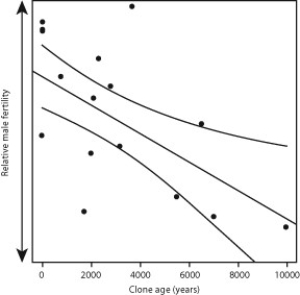Plants differ from many animals because they undergo indeterminate (continual) growth. Indeterminate growth is common in clonal plants because a single clone can continually produce new clones without undergoing sexual reproduction, even if the plant is capable of doing so.
Senescence, an inability to undergo cell division as an organism ages, also occurs in many plants and animals. However, scientists have had a difficult time establishing the occurrence of senescence in cloning plants because of their indeterminate growth patterns. Mutations in somatic cells are common during asexual growth, and these mutations lead to a decrease in sexual fitness. Scientists hypothesize that over time, as these mutations accumulate, they may contribute to senescence in clonal plants. To test this theory, scientists studied a naturally growing population of trembling aspen (Populus tremuloides) , a tree species that grows clones from its root system but is capable of sexual reproduction. To determine if trembling aspens senesce, they compared genetic data of estimated tree age with the variable of "diminishing fertility": the amount of pollen released by male aspen trees. Here are the results for this part of the study:
 Source: Adapted from Ally, D., Ritland, K., & Otto, S. P. (2010) . Aging in a long-lived clonal tree. PLoS Biol, 8(8) : e1000454. doi:10.1371/journal.pbio.1000454.
Source: Adapted from Ally, D., Ritland, K., & Otto, S. P. (2010) . Aging in a long-lived clonal tree. PLoS Biol, 8(8) : e1000454. doi:10.1371/journal.pbio.1000454.
-If you generalize the trends in data to 20,000 years, what can you conclude?
Definitions:
Parent-Child Interactions
The dynamic exchanges between a parent and child, including communication, behavior, and emotional responses, which influence the child's development.
Relational Aggression
A form of aggression aimed at damaging or manipulating relationships, including social exclusion and spreading rumors.
Instrumental Aggression
Aggressive behavior aimed at achieving a specific goal or obtaining an object, not merely to cause harm.
Sociometric Status
A measure of an individual's acceptance and popularity within a peer group, based on social networks and interactions.
Q4: If ocean waters in one area are
Q20: Which option correctly lists the sequence in
Q32: How could a population explosion of bacteria
Q34: One hypothesis for the development of myopia
Q35: When a New England farm is abandoned,
Q39: One way in which distributions of populations
Q46: A scientist suspects that the food in
Q47: After many hours of observation, Jennifer noticed
Q65: The recent National Health and Nutrition Examination
Q68: Apoptosis can be described as<br>A) programmed cell